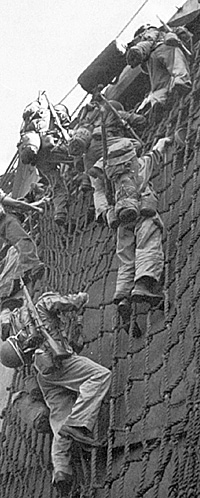 SOLDIERS OF THE 148TH REGIMENTAL COMBAT TEAM boarding the transport President Jackson for the run to Bougainville, 5 November 1943.
SOLDIERS OF THE 148TH REGIMENTAL COMBAT TEAM boarding the transport President Jackson for the run to Bougainville, 5 November 1943.
Now landed and completely protected from Japanese surface attack, although subject to frequent air raids by day and by night, the 3d Marine Division was hampered as much by terrain as by the enemy.
The swamps and dense forest slowed the movement of supplies and the building of roads and airfields. During their first five days on shore the marines patrolled, established antiaircraft and beach defenses, and extended the perimeter two thousand yards inland. (Map 16) Seventy-eight marines were killed or missing, 104 wounded. (This section is based on Morison, Breaking the Bismarcks Barrier, pp. 337-69; Rentz, Bougainville and the Northern Solomons, PP. 39-80; [British] Central Office of Information, Among Those Present, pp. 64-73; SOPACBACOM, The Bougainville Campaign, Chs. III- IV, V, OCMH; Halsey, Narrative Account of the South Pacific Campaign, OCMH; Harmon, The Army in the South Pacific, OCMH; I Mar Amphib Corps, Bougainville Beachhead; 8th Area Army Operations, Japanese Monogr No. 110 (OCMH), pp. 103-06; 17th Army Operations, II, Japanese Monogr No. 40 (OCMH), 104; the author's observations.)
More Troops
The first reinforcements, one battalion of the 21st Marine Regiment, arrived on eight LST's and eight APD's on 6 November. Escorted by six destroyers and covered by Task Force 39, these ships had sailed from Purvis Bay two days before. Japanese aircraft harried them during the night Of 5-6 November but did no damage.
For speedy unloading, the LST cargoes had been packed on trailers at Purvis Bay. But Cape Torokina did not boast very many beaches suitable for the LST's (which in the South Pacific almost never carried tanks). One beach at Puruata Island had room for three LST's, but using this meant unloading gear at Puruata and then transshipping it to the mainland. At the beaches east of Cape Torokina the LST's grounded offshore.
Seabees improvised coconut log runways, which failed to stand up under the strain. The eventual answer to the problem lay in steel pontons.
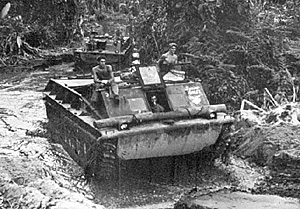 AMPHIBIAN TRACTORs LVT (i), carrying supplies and ammunition, move inland over a muddy
trail.
AMPHIBIAN TRACTORs LVT (i), carrying supplies and ammunition, move inland over a muddy
trail.
On 8 November substantial reinforcements came in, some aboard six of the ships that had made the initial invasion and then returned to Guadalcanal to pick up the 148th Regimental Combat Team of the 37th Division. Japanese aircraft made the day exciting as the soldiers unloaded and went ashore. Over a hundred planes attacked at noon. Twenty-eight Allied fighters from New Georgia kept many of them off, but some got through and damaged the President Jackson. Once ashore, the 148th relieved the 3d Marines on the left flank, and the marine regiment was assigned a position in the middle of the inland side of the perimeter defense.
General Geiger, having flown out from Washington and relieved General Vandegrift as corps commander, arrived at Bougainville on the 9th. On 13 November Admiral Wilkinson relinquished his control and Geiger became directly responsible to Halsey. The amphibious commander retained responsibility for the transport of troops and supplies to the beachhead.
Other reinforcements from the 37th and 3d Marine Divisions came in promptly. The 129th Regimental Combat Team landed on 13 November, and was followed six days later by the 145th.
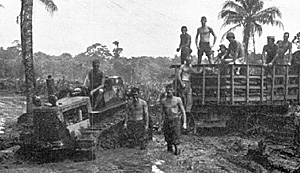 TRACTOR AND TRAILER IN MUD. Marines are perched on load of artillery ammunition.
TRACTOR AND TRAILER IN MUD. Marines are perched on load of artillery ammunition.
Except for miscellaneous units and detachments, this completed the movement of General Beightler's veteran division to the beachhead. The remaining units of the 21st Marines arrived on 11 and 17 November. During the latter shipment the APD McKean was fatally torpedoed by a Japanese plane. Thus by the end of the third week in November there were two full divisions at Empress Augusta Bay, plus substantial bodies of corps troops, naval construction battalions, and naval base forces.
The I Marine Amphibious Corps held a perimeter about sixteen thousand yards in circumference, including seven thousand yards along the beach. The 37th Division held the left, the 3d Marine Division the right. This perimeter was not attained without fighting, but the 37th Division was fortunate in that, except for patrol clashes, all the fighting occurred in the 3d Marine Division's zone.
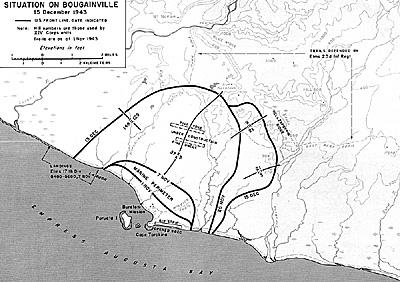 Expansion of the Perimeter
Expansion of the Perimeter
Even after 1 November Japanese Army commanders continued to cherish the delusion that the main effort was yet to come, and that southern Bougainville or Buka was the real target.
Jumbo Map: Situation on Bougainville (very slow: 274K)
However, on orders from Imainura to destroy the wide, shallow Allied beachhead at Cape Torokina, Hyakutake dispatched the two battalions of the 23d Infantry from the Buin area to the cape. Under command of Maj. Gen. Shun Iwasa, infantry group commander of the 6th Division, the 23d was to operate in conjunction with the 17th Division troops whose transfer from Rabaul, first planned for 1 November, had been postponed.
Aboard four destroyers, 475 men of this group finally got under way for Torokina on 6 November; 700 others sailed for Buka. The 17th Division troops were to cover the movement of the 23d Infantry by landing north of the cape near the Americans' left and creating a diversion. They would then move inland and join with the 23d. Iwasa was to advance down a trail with the combined force and attack the beachhead.
The troop-carrying destroyers hove to off the beach between the Laruma and Koromokina Rivers in the predawn darkness on the morning of 7 November. Between 0400 and 0600, the 475 soldiers slipped ashore in 21 landing craft under the very noses of the American defenders. Patrolling PT boats missed the destroyers, and an antitank platoon on shore saw the landing craft but thought they were American. The enemy soldiers landed so close to the American lines that they actually cut off several marines in an outpost, who were later rescued by two LCM's.
The Japanese attacked at once in the vicinity of a lagoon about fourteen hundrcd yards west of the Koromokina River. The sector was defended by troops of the 3d Marines who had just exchanged positions with the 9th Marines. General Turnage had ordered the transfer because the 3d had seen all the fighting on D Day, the 9th (which landed on the left) none, and there seemed to be no immediate prospect of fighting on the left. The enemy made some small local gains by infiltrating. The fighting, with rifles, machine guns, mortars, and grenades, was close work, but the marine lines held.
Next morning five field artillery batteries, plus mortars, antitank guns, and machine guns, fired a twenty-minute preparation into the Japanese position. Then the newly arrived 1st Battalion, 21st Marines, supported by light tanks, assaulted. It met only light opposition; the artillery preparation had come close to achieving perfection. Instead of engaging in a fierce fight, the ist Battalion walked, cautiously but steadily, through the jungle. It found, in the small area where the Japanese had packed themselves, about three hundred men killed almost instantaneously, their dead bodies lying beside their smashed weapons. In this action at Koromokina Lagoon the marines suffered sixteen men killed, thirty wounded.
Meanwhile the 23d Infantry had moved into position inland and had already begun attacking the trail blocks the marines had set up. Control of the trail system inland was of great importance to the security of the beachhead. It was clear that unless the Japanese had enough strength to deliver a major attack from the sea (and Admiral Sherman had settled that question on 5 November) any counteroffensives would be delivered along the axes of the trails. There were two important tracks at Cape Torokina, East-West Trail and the Numa Numa Trail. The latter ran from the shore near the mouth of the Piva River northward through the mountains to Numa Numa on the east coast. EastWest Trail intersected the Numa Numa Trail about five thousand yards inland (north) of the Piva's mouth. It led eastward, then north through the mountains to Roravana Bay and intersected the several trails leading to Buin. A local track, Mission Trail, ran from a point about two thousand yards north of the Piva mouth southwestward to the Roman Catholic mission station at Buretoni just northwest of Torokina.
On 5 November the 23d Infantry attacked a block on Mission Trail that was held by the 3d Raider Battalion. After the raider battalion beat off the 23d; it and later the 3d Battalion, 9th Marines, counterattacked up Mission Trail and by Armistice Day had advanced to the junction of Mission and Numa Numa Trails. Losing ig killed and 32 wounded, the marines estimated that they had accounted for 550 of the enemy.
Two days later the 21st Marines continued the fight, this time not only to keep control of the trails but also to cure an airfield site. Since landing the I Marine Amphibious Corps had also been hard at work pushing supply routes through the swamps, an extremely difficult and time-consuming task. At the same time patrols had found a good airfield site in a coconut grove by the right (West) bank of the Piva River near the junction of the Numa Numa and EastWest Trails. This was some distance from the 3d Division's front, and the difficulties of pushing supplies so far prevented an immediate forward displacement of the 3d Division to include the site.
Generals Geiger and Turnage therefore decided to establish a self-sustaining outpost at the trail junction in order to hold the airfield site. On 13 and 14 November troops of the 21st Marines, fighting hard against Japanese in prepared positions, made their way through the coconut grove and by 1600 of 14 November had seized the trail junction.
Because the building of roads and trails inside the beachhead eased the logistical situation, Geiger decided to move his whole front forward in the latter part of November. The 3d Division would advance on the east (right), the 37th Division on the west. Five artillery battalions, operating under the 37th Division artillery commander, Brig. Gen. Leo N. Kreber, would provide support, as would the Aircraft, Northern Solomons, under Brig. Gen. Field Harris, USMC. The 37th Division met no fighting in its advance but the 3d Marine Division continued to meet opposition from the 23d Infantry along the trails, especially on the Numa Numa Trail north of the airfield site and in the region northeast of that site where the East- West Trail crossed several tributary forks of the Piva River.
Here, between 2o and 24 November, the Japanese resisted vigorously but vainly. By 26 November the 3d Marine Division, maintaining contact on the left with the 37th Division, had extended its lines as far north as the south shore of Lake Kathleen, about 7,500 yards north of the Piva's mouth. In the fighting in the Piva forks the 3d Marines took the first high ground in the beachhead. Along the shore line the I Corps held the beach from a point 6,000 yards northwest of Cape Torokina to a point 3,500 east of the cape. The inland lines of the perimeter were about 19,500 yards long.
During November the Japanese Army commanders still refused to believe that Halsey had made his main effort at Empress Augusta Bay and therefore undertook no counterattacks on a scale large enough to be effective. But Rabaul-based aircraft continued to raid the beachhead. Both division command posts were hit, as were several fuel and ammunition dumps, which blew skyward in impressive and expensive displays. On a few occasions the enemy planes swooped down suddenly over the mountains during daylight and caught the beachhead by surprise (the mountains blocked the radar beams), but most of the bombings were nocturnal, and the Japanese simplified the radar operators' problems by attacking from seaward where they were easy to locate in time for warning to be given and the antiaircraft guns to go into action. Puruata Island, with phosphorescent water outlining it clearly, was a favorite and profitable target, since it was nearly always packed with supplies awaiting transshipment to the mainland. (In the early hours of 20 November a Japanese plane scored a direct hit on one of the 90-mm. guns of F Battery, 3d Defense Battalion, on Puruata that killed five and wounded eight of the crew as well as knocking the gun out of commission and blowing up a fuel dump.)
These attacks did not jeopardize the security of the beachhead but they were a costly nuisance. Of ninety air alerts in November, twenty-two resulted in bombings and strafings that killed twenty-four men and wounded ninety-six. In addition to the antiaircraft guns a few PV-i night fighters from New Georgia defended against Kusaka's fliers. Though their losses were lighter than in daylight attacks, the Japanese lost several planes to the night fighters and the antiaircraft batteries.
Battle of Cape Saint George
So sure were the Japanese that Buka was an ultimate target that they continued to send reinforcements there. Late in November 920 soldiers on board three destroyers with two more escorting attempted to get to Buka. They were intercepted in the Solomon Sea during the night of 25 November by Captain Burke's destroyer squadron, which chased them from near Buka almost to Cape Saint George, the southern tip of New Ireland. Burke's ships sank three destroyers without receiving as much as one hit themselves.
This action, the Battle of Cape Saint George, was the last of the night surface engagements which had characterized the Solomons campaigns since the one off Savo Island on 8 August 1942. (For details see Morison, Breaking the Bismarcks Barrier, PP. 352-59.)
In November and December at Empress Augusta Bay the indefatigable Japanese had begun to emplace artillery of calibers as high as 150-mm. on the high ground around the beachhead, especially in a group of hills that lay east of the Numa Numa-East-West Trails' junction and paralleled the west bank of the Torokina River. With these guns they shelled the beachhead, especially the airstrips and the supply dumps.
The 3d Marine Division reacted by extending its lines to include the hills in a series of operations that lasted from 9 December through 27 December. One eminence, Hellzapoppin Ridge, was a natural fortress three hundred feet long, with sharp slopes and a narrow crest. It overlooked much of the beachhead and was an excellent site for artillery. Here the Japanese had constructed extensive positions on the reverse slopes using natural and artificial camouflage.
The 21st Marines attacked Hellzapoppin Ridge but were driven off on 18 December. Several air strikes missed the narrow ridge completely. Finally, co-ordinated air (TBF's dropped 100-pound bombs with delay fuzes), artillery, and infantry attacks resulted in the capture of Hellzapoppin on Christmas Day. In the air strikes success was finally attained by marking the American front lines with colored smoke and designating the enemy targets with white phosphorus.
By 15 December the Americans held their final defensive line, a perimeter defense that extended on its inland side for about 22,500 yards. Over 44,000 men were present. Construction of the defense perimeter had begun in some sectors on 25 November, and by 15 December the work was complete. The line consisted of two-man foxholes, trenches, emplacements for automatic weapons, mortars, antitank guns, and artillery, with alternate positions for all weapons. Fields of fire were cleared for 100 yards in front of the lines but all possible foliage was left in place overhead. The field artillery, grouped under command of General Kreber, was sited to fire in support of any threatened sector, and all weapons were registered and adjusted for every possible avenue of approach. All trails were blocked, and the approaches to the swamps were mined. Whenever possible machine guns were posted in commanding positions on high ground.
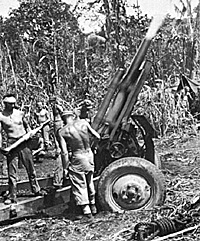
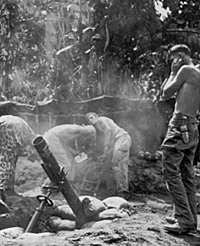 Right: 105mm HOWITZER of the 135th Field Artillery Battalion in action.
Right: 105mm HOWITZER of the 135th Field Artillery Battalion in action.
Left: 4.2-INCH CHEMICAL MORTAR firing in support of infantry troops.
The 4.2-inch chemical mortars were so sited and adjusted that they could place their fire directly in front of the infantry. The whole front was wired in behind two rows of either double- apron or concertina barbed wire, and the wire was full of trip wires and of cans hung up to rattle when an enemy approached the wire.
Several antiaircraft searchlights were set up to illuminate the front at night, either directly or by throwing up widely spread beams that would be reflected down from the clouds. The defenses were formidable, and it would be some time before the Japanese got around to testing them thoroughly. Meanwhile life inside the perimeter promised to be relatively agreeable.
More Exploiting the Beachhead
Back to Table of Contents -- Operation Cartwheel
Back to World War Two: US Army List of Issues
Back to MagWeb Magazine List
© Copyright 2002 by Coalition Web, Inc.
This article appears in MagWeb (Magazine Web) on the Internet World Wide Web.
Other military history articles and gaming articles are available at http://www.magweb.com